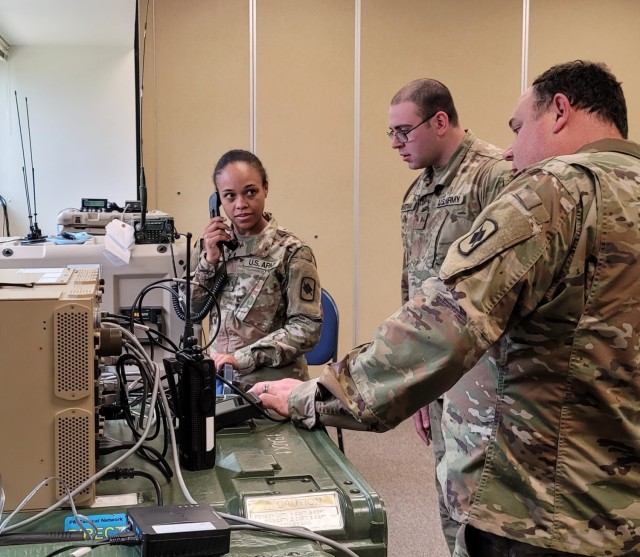
LITTLE ROCK, Ark. — A theme echoed with repetition throughout last week’s 2022 Army National Guard G-6 Tactical Communications Conference stressed the importance of data and rapid resilient data transport as the Army evolves its network of 2030.
“The Army is looking at how to improve long-haul data transport, the management of data and data traffic, getting the right data to the right people at the right time to make the right decisions,” said Col. Isaac Martinez, Army National Guard Chief Information Officer and Network Communications Officer. “And we are learning every day about the importance of speed in getting that data to commanders to make those decisions.”
The Army National Guard represents 33 percent of the Army’s signal force, Martinez said. “Network modernization is an enduring mission across the total force, and we need to not only understand what the future network looks like, but we need to make sure we have the right people in the right positions to operate it.”
During the three-day conference, held at the National Guard Professional Education Center in Little Rock, Army and Army National Guard network communications leaders updated an audience of Guard signal officers on current network modernization fielding efforts and future modernization goals.
To achieve these goals, the Army continues to conduct Soldier-driven pilots and Soldier feedback activities to inform and improve network capabilities in support of the service’s iterative network modernization capability sets. For example, the Army National Guard is directly participating in Army tactical cloud pilots. Near-term opportunities also exist for the Guard to observe command post experimentation and participate in additional Soldier touch points.
“The Army set up its network modernization capability sets on a two-year iterative cycle so we can better align the evolution of technology with Army processes, such as requirements development and funding; this enables us to keep up with the rapid pace of technology [as well as changes in Army mission sets],” said Ward Roberts, assistant program executive officer Acquisition Strategy for Program Executive Office Command, Control, Communications-Tactical.
The Army’s network modernization Capability Set, or CS, 21 focuses on expeditionary and intuitive capability for infantry formations; CS23 on capacity, resiliency and convergence for mounted formations and division as a unit of action; CS25 focuses on automated and protected network capability, mounted formations and divisions, and with CS27+ units become multi-domain capable.
Current and future network capability sets hone in on transport agnostic capabilities that enable high-speed, high-capacity, automatic multi-path transport that is seamless to the user.
“The user shouldn’t have to worry about how they get their data, they just need to get it,” said Col. Evert Hawk, Network Cross Functional Team Lead, assigned to the Army Futures Command. “They shouldn’t have to worry about pulling switches; it should just be there for them. The transport needs to be reliable, whether its traditional geosynchronous Earth orbit, or high-throughput low-latency low Earth orbit or medium Earth orbit satellite capabilities.”
Hawk elaborated on this concept adding that the Army’s transport-agnostic data-centric systems are underpinned by a zero trust security architecture.
“Data-centricity is our foundational focus for network modernization; and whether we are securing data or the transport, network security is embedded in everything we do,” Hawk said. “We need to protect ourselves from a cyber defense perspective.”
Army National Guard units have a unique dual role supporting both federal and state missions. During the conference, to address current operations on the homeland, the Program Executive Office Command, Control and Communications-Tactical with support from the Arkansas Army National Guard 239th Brigade Engineering Battalion, provided a demonstration of the Disaster Incident Response Emergency Communications Terminal, or DIRECT, tool suite.
The DIRECT equipment set enables Guard signal units to provide commercial phone, internet access, command post Wi-Fi and radio interoperability to first responders — military, government and non-governmental — during domestic natural disasters, emergencies and civil support operations. Each system is an Army program of record that is integrated together to support the Guard’s unique state missions.
“The intent of the system is to support first responders; such as local emergency medical services, fire and police during homeland missions such as tornado response efforts, or we can deploy to support another state,” said 2nd Lt. Hunter Cheatham, Arkansas Army National Guard 239th Brigade Engineering Battalion. “Compared to our previous system, it offers more functionality, is easier to use and the modular modernized commercial equipment can be more easily updated [as technology matures].”
As the Army continues to modernize its network, the service is focused on the entire force, leveraging Soldier feedback and fielding enhanced systems across all three components, or COMPOS — active-duty Army, National Guard and Reserve – in support of a wide variety of dynamic mission sets, Roberts said.
“That means we need to understand interoperability requirements and make sure COMPO 2 and 3 units are seamlessly integrated with the Active Duty units; the architecture has to be designed to enable that and fielding has to be aligned to support it,” Roberts said.





Social Sharing